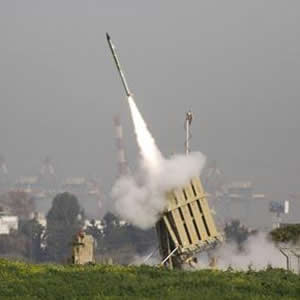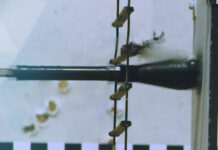Israel launched Operation “Pillar of Defense” on November 14 2012, in order “to improve the security situation and deliver a painful blow to Hamas. The main reason for striking at Hamas was to weaken – if not to completely destroy – its ability to launch rockets at Israel’s civilian population.
Rockets have been launched steadily from the Gaza Strip for some years, and Hamas began firing its homemade Qassam rockets even before the IDF withdrawal from Gaza in 2005. Since then there have been repeated cycles of calm with occasional rounds of escalation.
In recent years, Hamas and the other organizations operating in the Gaza Strip have switched to using standard rockets smuggled into Gaza through a variety of routes. The inventory of rockets has gradually increased, and on the eve of Operation Pillar of Defense, it was estimated at some 15,000.
Most of the rockets held by Hamas and the other organizations in Gaza are of military quality, 107-mm and 122mm Grad rockets. These rockets, of Soviet design, have been in use since the 1960s. They are manufactured in dozens of countries around the world (including most former members of the Warsaw Pact, as well as China, North Korea, Iran, and Egypt). The original 122mm Grad rocket has a range of some 20 kilometers; some of the recent versions of the Grad have an increased range, up to about 40 kilometers.
The close relations between Hamas and Iran led to the possession of longer and more lethal Fajr-3 and Fajr-5 rockets. The Fajr-5 is an Iranian-made 333mm rocket with a range of about 75 kilometers. The organizations have recently aimed to achieve some self-sufficiency by producing their own rockets, as Israeli covert attacks on smuggling routes from Iran through Sudan and Sinai became more effective. As early as two years ago, for example, a rocket that struck Israel with a range of 21 kilometers was identified as a local imitation of a Grad. Further improvements in their indigenous capabilities was evident during Pillar of Defense, when Hamas boasted use of a homemade rocket called M-75, with a range of 75-80 kilometers, comparable to that of the Fajr-5.
Israel’s defense doctrine for mitigating the threat posed by high-trajectory weapons is a multi-layered doctrine (“high-trajectory” is a broad term that includes a wide range of threats – from mortar and other artillery shells, through short-range rockets, long-range rockets, and various ballistic missiles). It comprises deterrence; attacks on the enemy’s launch abilities within its territory and active defense, which includes systems of multi anti- missile systems: Arrow 2 (operational) and Arrow 3 (under development), David’s Sling (to become operational 2014), intended to intercept longer-range rockets with a range of up to 200 kilometers, and the Iron Dome system.
Iron Dome is a system for active defense against rockets with short ranges up to 70 kilometers as well as against artillery shells. Rafael Advanced Defense Systems developed it in cooperation with IAI/Elta Systems, which produces the radar, and mPrest, which is responsible for the command and control system. Iron Dome uses an interceptor missile to shoot down rockets. One of the important characteristics of the system is its ability to calculate the trajectory of the tracked rocket. It does not engage rockets predicted to fall in an open and unpopulated area. The system entered operational service in early 2011, and its first operational interception was of a rocket fired at Ashkelon on April 7, 2011. On the eve of Operation Pillar of Defense, there were four operational Iron Dome batteries in the IDF’s order of battle. A fifth battery that was scheduled to be deployed in January 2013 but was rushed into operational service during Pillar of Defense, and on November 17, it was deployed for defense the metropolitan area surrounding Tel-Aviv.
During Operation Pillar of Defense, 1,506 rockets were fired at Israel. Of these, 152 were failed launches, 875 fell in unpopulated areas, and 421 were successfully shot down by the Iron Dome system, which achieved a success rate of 85 percent. Only 58 rockets fell in built-up areas with only six Israeli citizens were killed. The success of the Iron Dome system was given as the main factor that obviated the necessity to initiate an IDF ground operation in Gaza. As a result of the system’s success, a ministerial committee approved a budget of NIS 750 million to expand acquisition of the Iron Dome system, with the declared intention of eventually acquiring 13 batteries.
There is no doubt that from a technological and operational-tactical point of view, the Iron Dome system achieved tremendous success. Iron Dome is a unique system, and it has no counterpart anywhere in the world. The very nature of its success tends to make people forget, or even worse, to automatically dismiss criticism of the concept underlying the weapon system. In the case of Iron Dome, the process of its development and acquisition was accompanied by considerable criticism on several levels: technological, operational-tactical, and conceptual strategy. There were claims that shorter-range incoming rockets were not intercepted and that the cost was too high and could not be sustained for an indefinite period. Defense analysts also advised that as the enemy will certainly try to counter Iron Dome, measures should be taken to develop sufficient means to intercept larger salvoes. Hamas already tried to fire simultaneous rockets, in salvos of over 10 rockets that were repeatedly intercepted by Iron Dome.
The direct cost of using Iron Dome was estimated at about NIS 160 million. Although a substantial amount it represents modest expenditure of some 5 percent of the total cost of the operation. The system operated until the end of the hostilities. Given the absence of non-classified information, it cannot be estimated how long the interceptor supplies would have lasted, although Rafael worked round the clock to produce throughout the entire period and after. It can only be estimated that in future wars, the inventories of Iron Dome interceptors are likely to be an important operational factor and sufficient storage be kept available.
On the strategic level, a salient argument was that the system gave decision makers the freedom to act judiciously, and in particular, that the system’s success made it unnecessary to launch a ground operation in the Gaza Strip.
Questions for the Future
When the dust settles and the feeling of euphoria over the system’s success during Operation Pillar of Defense subsides, it will be necessary to seriously examine several questions that remain unanswered. First, what should be protected? Iron Dome was deployed to defend the civilian population. This choice was justified because the civilian population was the target of the rocket attacks in the current round. However, under severe circumstances such as those predicted for a future conflict with Hezbollah, which is equipped with a much larger number of rockets, some of which are significantly more accurate than the rockets Hamas possesses, the question will arise whether to protect the civilian population or to divert resources towards protecting strategic and military assets.
Second, how many batteries are needed? A rough estimate considers at least twenty batteries able to cover most of Israel’s territory. In order to reduce the unit cost export opportunities should become crucial. Countries like South Korea and Singapore have already expressed an interest in the system, and some military defense officials in the United States have called on the US Army to consider buying the Iron Dome system to support ground units such as those deployed in Afghanistan.
In Operation Pillar of Defense Israel has just proven that its new Iron Dome system can repel Hamas’ short-range rockets and missiles. But the question remains whether those weapons can counter the more advanced missiles that Hezbollah and Iran can throw at Israel, which would surely overwhelm Iron Dome. That may be a reason why Israel, and the United States of America are already looking into the missile defense systems beyond Iron Dome, including ones that rely on directional high-energy solid-state lasers.




















